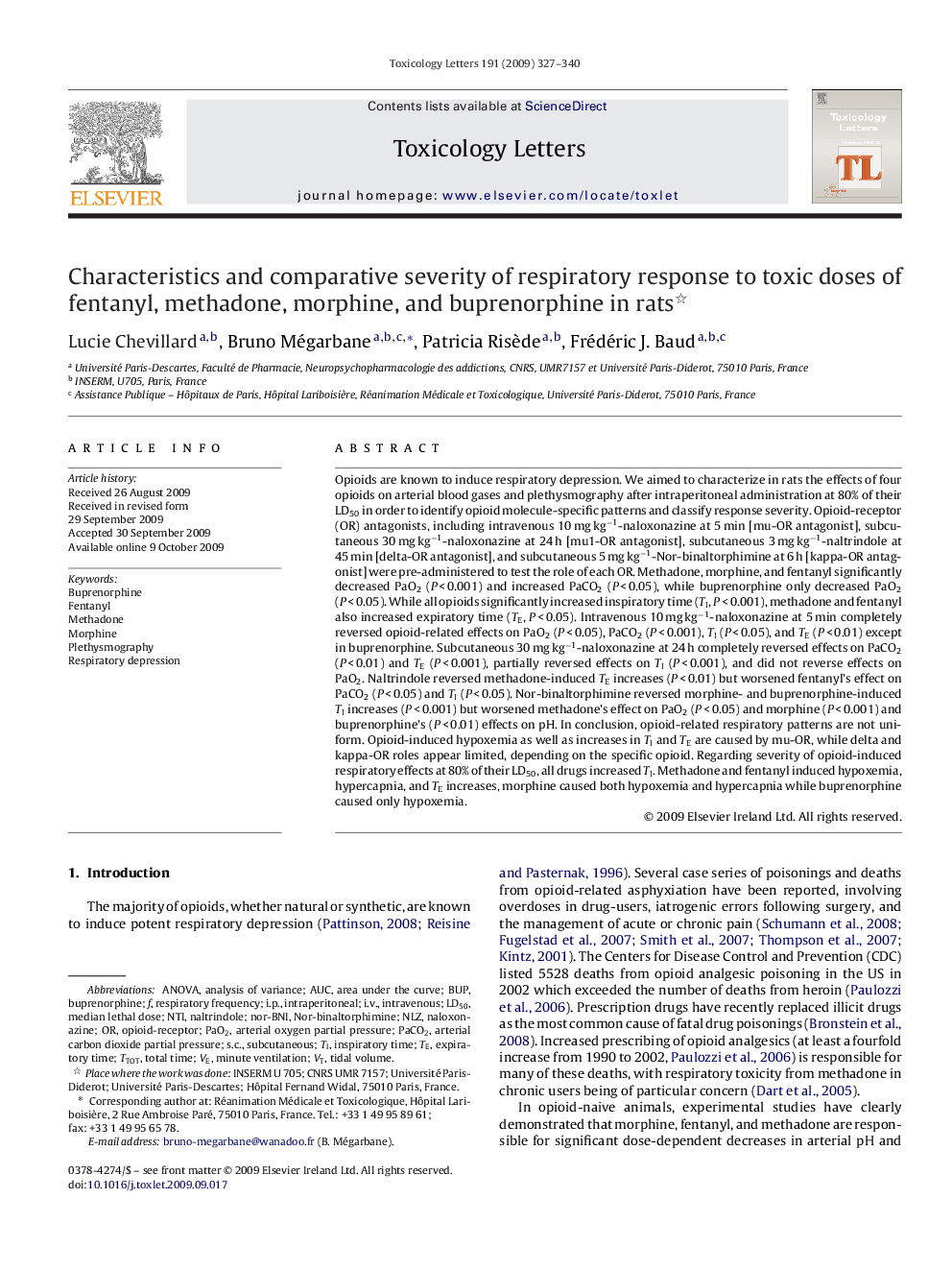| کد مقاله | کد نشریه | سال انتشار | مقاله انگلیسی | نسخه تمام متن |
|---|---|---|---|---|
| 5860937 | 1562642 | 2009 | 14 صفحه PDF | دانلود رایگان |
عنوان انگلیسی مقاله ISI
Characteristics and comparative severity of respiratory response to toxic doses of fentanyl, methadone, morphine, and buprenorphine in rats
دانلود مقاله + سفارش ترجمه
دانلود مقاله ISI انگلیسی
رایگان برای ایرانیان
کلمات کلیدی
i.v.opioid-receptorarterial oxygen partial pressureTTOTNTIBUPPaO2s.c.PaCO2LD50i.p.TV, Tidal volume - حجم جاری، هوای جاریAUC - AUCNaltrindole - آن را بشکنیدbuprenorphine - بوپرنورفینanalysis of variance - تحلیل واریانسANOVA - تحلیل واریانس Analysis of varianceminute ventilation - تهویه ده دقیقهintraperitoneal - داخل صفاقیIntravenous - داخل وریدیRespiratory depression - دپرسیون تنفسیinspiratory time - زمان الهام بخشexpiratory time - زمان انعقادsubcutaneous - زیر جلدیrespiratory frequency - فرکانس تنفسیFentanyl - فنتانیلMethadone - متادونarea under the curve - منطقه تحت منحنیmorphine - مورفینmedian lethal dose - میانگین دوز مرگبارNaloxonazine - نالوکسانازینNor-BNI - نور BNINor-binaltorphimine - نور باینلورفیمیمPlethysmography - پتسیموگرافی
موضوعات مرتبط
علوم زیستی و بیوفناوری
علوم محیط زیست
بهداشت، سم شناسی و جهش زایی
پیش نمایش صفحه اول مقاله

چکیده انگلیسی
Opioids are known to induce respiratory depression. We aimed to characterize in rats the effects of four opioids on arterial blood gases and plethysmography after intraperitoneal administration at 80% of their LD50 in order to identify opioid molecule-specific patterns and classify response severity. Opioid-receptor (OR) antagonists, including intravenous 10 mg kgâ1-naloxonazine at 5 min [mu-OR antagonist], subcutaneous 30 mg kgâ1-naloxonazine at 24 h [mu1-OR antagonist], subcutaneous 3 mg kgâ1-naltrindole at 45 min [delta-OR antagonist], and subcutaneous 5 mg kgâ1-Nor-binaltorphimine at 6 h [kappa-OR antagonist] were pre-administered to test the role of each OR. Methadone, morphine, and fentanyl significantly decreased PaO2 (P < 0.001) and increased PaCO2 (P < 0.05), while buprenorphine only decreased PaO2 (P < 0.05). While all opioids significantly increased inspiratory time (TI, P < 0.001), methadone and fentanyl also increased expiratory time (TE, P < 0.05). Intravenous 10 mg kgâ1-naloxonazine at 5 min completely reversed opioid-related effects on PaO2 (P < 0.05), PaCO2 (P < 0.001), TI (P < 0.05), and TE (P < 0.01) except in buprenorphine. Subcutaneous 30 mg kgâ1-naloxonazine at 24 h completely reversed effects on PaCO2 (P < 0.01) and TE (P < 0.001), partially reversed effects on TI (P < 0.001), and did not reverse effects on PaO2. Naltrindole reversed methadone-induced TE increases (P < 0.01) but worsened fentanyl's effect on PaCO2 (P < 0.05) and TI (P < 0.05). Nor-binaltorphimine reversed morphine- and buprenorphine-induced TI increases (P < 0.001) but worsened methadone's effect on PaO2 (P < 0.05) and morphine (P < 0.001) and buprenorphine's (P < 0.01) effects on pH. In conclusion, opioid-related respiratory patterns are not uniform. Opioid-induced hypoxemia as well as increases in TI and TE are caused by mu-OR, while delta and kappa-OR roles appear limited, depending on the specific opioid. Regarding severity of opioid-induced respiratory effects at 80% of their LD50, all drugs increased TI. Methadone and fentanyl induced hypoxemia, hypercapnia, and TE increases, morphine caused both hypoxemia and hypercapnia while buprenorphine caused only hypoxemia.
ناشر
Database: Elsevier - ScienceDirect (ساینس دایرکت)
Journal: Toxicology Letters - Volume 191, Issues 2â3, 15 December 2009, Pages 327-340
Journal: Toxicology Letters - Volume 191, Issues 2â3, 15 December 2009, Pages 327-340
نویسندگان
Lucie Chevillard, Bruno Mégarbane, Patricia Risède, Frédéric J. Baud,